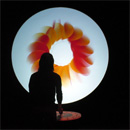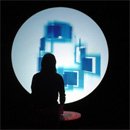| Index / RPM / Path / O-Cell / Thesis / Trundle / Vehicle4 / Atmosphere | ||
 |
||||||||
| RPM
RPM is a dynamic system for analyzing and experiencing relationships between time and space. Manipulating the location, phase, speed, and transparency of multiple instances of the same moving object creates new kinematic forms. A custom physical interface is coupled with a projected image to create a synthesis between tangible and image space. RPM is inspired by past technological developments used to augment vision. After the development of the camera in the mid 19th century, men such as Eadweard Muybridge and Etienne-Jules Marey began using its potential to stop time and analyze details of movement that had never before been visible to the human eye. In the 1930s, Harold Edgerton pioneered the process of stroboscopic photography which enabled capturing the successive movements of an object with a still camera. Utilizing this technique, the photographs of Herbert Matter and L. Moholy-Nagy began to reveal a new vision, a sight unbound from time. The medium of computation has provided a platform for further extending our vision. RPM combines concepts from old and new technology into a system for constructing a new vision. It augments the early experiments in time and motion by providing tools for manipulation made possible through computation. RPM has been exhibited at Interaction'01 in Ogaki and at the Bitforms Gallery in New York. |
||||||||
 |
 |
 |
||||||
|
|
||||||||
© 2002, 2001 | Casey Reas |
|